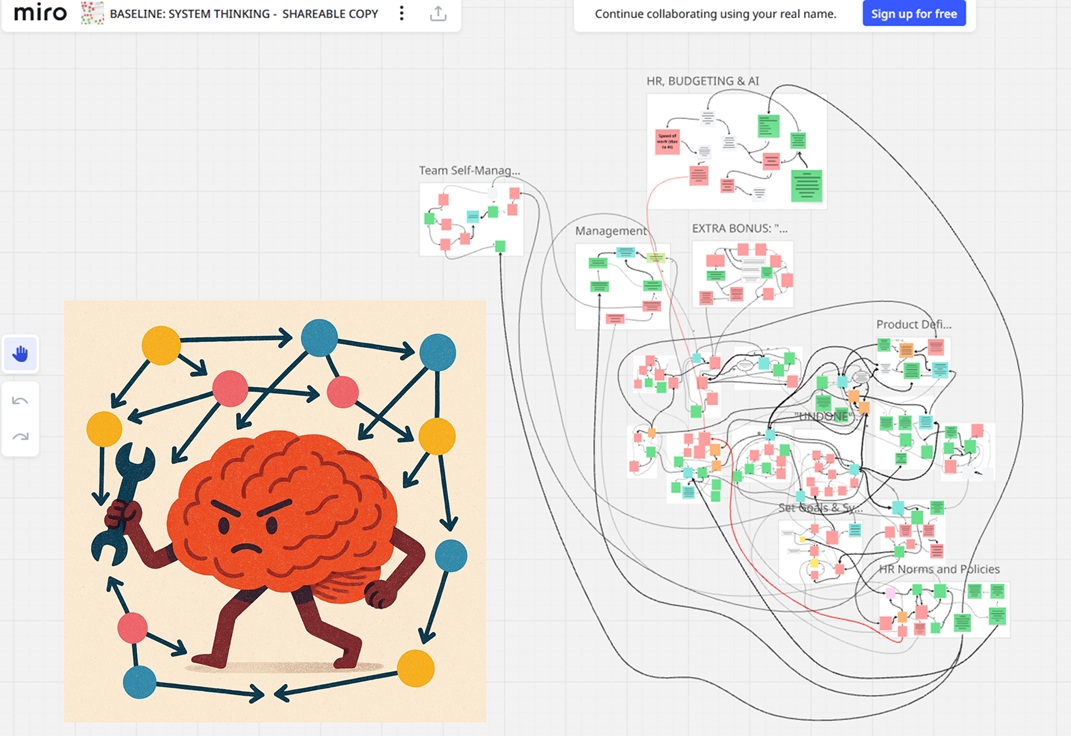Introduction
Organizations are not simple machines that can be tuned by tightening one screw or swapping out one part. They are living ecosystems made up of people, processes, tools, and norms. These ecosystems operate through dynamic cause-and-effect relationships—feedback loops that can either improve, stabilize or deteriorate the system.
System Thinking provides a way to see the whole rather than fragmented pieces. By modeling organizational dynamics, using causal loop diagrams (CLDs), we expose not just direct cause-and-effect chains, but also delayed effects, unintended consequences, and reinforcing loops. Much like a solar system within a larger universe, each part of an organization functions locally but also interacts constantly with other parts of an organization.
This writeup summarizes a complex organizational system model that is taught in Large Scale Scrum (LeSS) class, highlighting the interdependencies, quick fixes, delays, and other cause and effect relationships that emerge when people intervene in one part of the system, causing result in another part.
Parts Of The Whole System (Examples) and Their Dynamics
1. Goal Setting & System Gaming
- Developers and managers set goals around velocity and rewards. Is there any danger in that?
- Pressure to meet numbers creates gaming behavior, where outputs are inflated but defects rise.
- More defects create rework and reliance on low-skilled developers, which reduces the very velocity the system was trying to optimize for.
- The reinforcing loop shows how short-term targets undermine long-term system improvement.
It is clear that a true, systemic improvement in metrics cannot succeed unless connected to capability building and quality practices elsewhere in the system.
2. Product Ownership, Analysis & Design
- Overreliance on proxies (BAs, pseudo-POs) and contractual roles disconnects teams from real customers and users.
- As product definitions become diluted, the organization creates false initiatives, to create an illusion of being busy, leading to overall waste.
- Conversely, when developers understand the business domain and empathize with customers, they produce solutions with lasting value, and by doing so, render other, “left over” roles obsolete.
It becomes apparent that organizational waste is not reduced by more budgetary control, but by reconnecting delivery teams with authentic product ownership and customer feedback.
3. Scrum Master Role & Agile Theater
- Organizations often over-invest in appearances—low-quality Scrum Masters, “Agile Coaches”-title flippers and ceremonial reporting.
- This creates Agile Theater: the rituals are visible, but outcomes remain shallow.
- However, when a supportive Scrum Master community is fostered, real organizational improvements emerge—because experimentation, learning, and autonomy are protected.
This illustrates the paradox: simply adding roles can reinforce dysfunction, but supporting the right environment creates systemic improvement.
4. Budgeting & Finance
- Rigid budgeting cycles drive year-end urgency and poor hiring decisions.
- The urgency to “spend before losing funds” reduces candidate quality and increases the number of low-skilled developers, feeding into the system gaming loop.
- Dynamic budgeting, instead, enables product-oriented investment and reduces waste across the system.
This cluster shows how financial policy decisions ripple far beyond finance—impacting hiring, delivery quality, and even cultural norms.
5. HR Norms & AI
- HR practices emphasizing individual KPIs foster competition and rivalry, undermining peer-to-peer support and team synergy.
- Systemic use of AI changes the balance further—improving speed of work, but also driving layoffs and a redefinition of roles.
- Long-term improvement only comes from multi-learning career paths that balance AI automation with human adaptability.
This “solar system” highlights how cultural reinforcement and technology adoption cannot be separated—organizational resilience depends on both.
6. Technical Excellence & Product Backlog
- When teams limit work in progress and release in small batches by using automation, transaction costs drop, and adaptability rises.
- Pride in work and belonging to a whole product view reinforce team motivation, further improving quality.
- Conversely, fragmented backlogs and pseudo-products dilute purpose and raise waste.
This is a classic example where one key discipline (technical excellence) cascades into system-wide agility and waste reduction.
Interconnected “Universes”: How Systems Interact
Although each cluster behaves as a local solar system, arrows between them show how everything is bound in a larger organizational “universe”:
- Budgeting influences Hiring, which shapes System Gaming loops.
- HR Rivalry norms weaken Team Synergy, which undermines Technical Excellence.
- Agile Theater reduces authenticity in Scrum Master roles, which in turn blocks long-lasting improvements.
- Product Ownership defines whether customer feedback influences backlog prioritization, cascading into either waste or value creation.
The central insight: no cluster can be “fixed” in isolation. Improvements emerge when leaders tune one solar system with awareness of its gravitational pull on others.
Conclusion: Seeing the Whole Universe
System Thinking is powerful because it teaches us that local fixes are illusions. What looks like a solution in one part of the system often creates unintended consequences elsewhere. A new metric, a new role, or a new budget cycle may reinforce dysfunction if seen in isolation.
The true power of System Modeling is that it allows us to:
- Visualize complexity—understanding not just linear causation but feedback, delay, and gaming loops.
- Reveal hidden leverage points—showing that to improve feature velocity, we may need to reform budgeting cycles, not push developers harder.
- Treat organizations as universes—with solar systems of variables that must be balanced together, not managed in silos.
When organizations learn to see themselves through this lens, they move beyond firefighting and quick fixes toward lasting improvement and resilience. System Thinking is not just an analysis tool—it is a way of governing the complexity of modern organizations.

